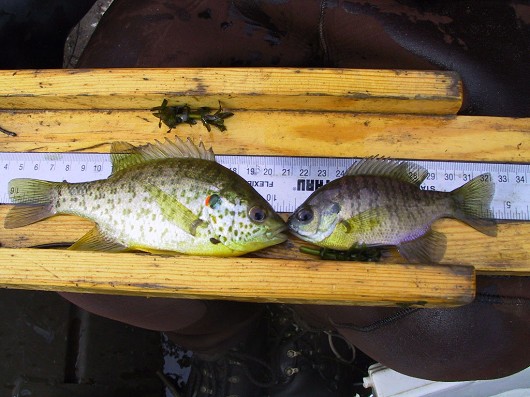Redear sunfish
-
Scientific NameLepomis microlophus
-
NativeNo
-
Identification
 Redear sunfish (left) and bluegill (right). Photo courtesy of Professor Peter B. Moyle.
Redear sunfish (left) and bluegill (right). Photo courtesy of Professor Peter B. Moyle.- Deep bodied
- Small oblique mouth
- Long pointed pectoral fins
- Opercular flap has an orange-red edge ahead of a dark splotch
- Coloration:
- Dorsal fin dusky without a dark spot near the rear
- Adults light olive on the back, pale mottled brown to silver on the sides, often with speckling and yellow on the lower sides and belly
- Young-of-the-year can have 7-8 vertical bars on the side (faint)
- 10 spines and 11-12 rays in the dorsal fin
- 3 spines and 10-11 rays in the anal fin
- 13 rays in the pectoral fins
- 1 spine and 5 rays in the pelvic fins
- 34-43 scales on the lateral line
-
Life History
Redear sunfish are most commonly found in the deeper waters of warm, quiet ponds and lakes, or in back waters and sloughs with substantial beds of aquatic vegetation. They will avoid turbid or shallow water where increased food competition limits their reproductive ability. They can survive in salinities up to 20 ppt but in California they tend to avoid brackish water. Hard shelled invertebrates make up the majority of the redear sunfish diet, with bottom dwelling snails and clams and aquatic plants being the most common targets. This is made possible by molar-like teeth that can crush shells, allowing inedible parts to be ejected and soft parts digested. While the hard shelled prey items are the most common food for the redear sunfish this because they are so readily abundant. Bottom dwelling insect larvae like dragonflies and midges are actually preferred and become more important in the summer when they become more abundant.
Redear sunfish are estimated to reach maturity in California in approximately 3-4 years or when they have grown to between 13 cm and 18 cm in length. Spawning occurs throughout the summer when temperatures reach 21-24°C, potentially as early as mid-April in lowland areas. Males construct 25-61 cm wide nest depressions in sand, gravel, or mud 5-10 cm deep. The nests are built in colonies to protect them from outside predators but each individual male will also strictly defend his nest from other males in the colony. Most males guard the nests until the embryos hatch but it is believed that there are multiple mating strategies for male redear sunfish that may relieve some of this duty (see bluegill page for potential scenario). Females will lay 9,000-80,000 eggs per season in multiple males’ nests, the number increasing with age and size. When the eggs hatch 3-5 days later the larvae make their way into open water where they will feed on plankton before settling into a bed of aquatic vegetation several weeks later.
Growth can be quite variable, with a small turbid lake producing fish 48 mm long in their first year and 163 mm in their fourth, while a larger, clearer lake may produce fish 69 mm their first year and 170 mm in their fourth. However, growth rates in these large lake populations can level off near 200 mm, while fish in smaller lakes will see continued growth, resulting in 5-6 year olds that average 254 mm. The largest recorded redear sunfish was 2.4 kg and the oldest was 7 years old.
-
Links to Other ResearchN / A
